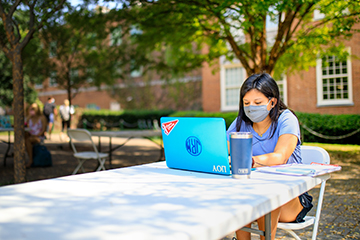
Faculty in Samford University’s School of Public Health are no strangers to online instruction as the school’s graduate degree programs are all offered online. But as undergraduate students returned for a new academic year this fall, our faculty proved to go above and beyond in their work to engage students—through in-person, hybrid and online classes—adapting and expanding the educational experiences they offer, despite the obstacles created by COVID-19.
Enriching Student Engagement
Assistant professor Lakesha Kinnerson teaches Introduction to Health Informatics and Information Technology, a course required for health informatics and analytics, public health, and healthcare administration majors but is open to all Samford students as an elective. As she prepared for the semester, she knew that technology would play an important role, enriching the course experience and supporting continuity of instruction.
“This fall, I implemented a theory-to-practice approach. The course has lectures, however, students have practice-based assignments throughout the semester that reinforce the lectures,” Kinnerson said.
Most of these assignments utilize EHR-Go, a simulation software designed for students to interact with an electronic health record. “There are multiple assignments where they get to learn about the different components of the electronic health record, and in doing so, they’re able to incorporate medical terminology, anatomy and physiology, financial components and population health aspects,” she said.
By developing the student’s knowledge of the software at the start of the semester, Kinnerson has found students are able to engage deeper into each project as the course progresses. “Then, at the end, they have a product that they can look back and say, I created this,” she said. “It’s a partnership because it’s not just theory. They are building on that theory to actually realize what we’ve discussed. And ultimately, it’s all about helping patients have better outcomes by using and understanding health data.”
Taking A Deeper Dive
Faculty members Kim Davey, Rachel Bailey and Ahinee Amamoo in the school’s Department of Public Health offered a special cadre, or small group, this fall for students to analyze and engage in conversations about the world’s response to COVID-19.
The cadre, entitled “Pandemics: Spiritual, Social and Scientific Responses” attracted undergraduate students from a variety of disciplines and backgrounds. Together, they are reading the book The Great Influenza: The Story of the Deadliest Pandemic in History and discussing the intersection of public health, science and faith during a global pandemic.
The group meets each Tuesday via Zoom, and will continue for eight weeks. “We knew we needed to offer an additional opportunity for students to explore important topics related to the global pandemic we’re experiencing. Each week, our discussions revolve around themes like hope and history, calling and spiritual gifts, as well as pestilence and death,” Davey said.
Ensuring Student Internships
As COVID-19 began to change the way in which students completed internships, cutting some short and moving others to an online format, faculty had to think fast, especially for students in the school’s healthcare administration major, which requires students to complete two internships of 120 hours each.
In collaboration with Carol Ratcliffe, professor and chair of the school's Department of Healthcare Administration and Informatics, and the program’s certification body, AUPHA, Courtney Haun, assistant professor and director of the healthcare administration undergraduate program, worked to compile a catalog of free online content offered through Coursera.org, making it possible for students to earn internship hours by completing online courses.
“These courses are developed by educational institutions, consultants, firms and prominent individuals, and we compiled a collection of free courses that correlate with important topics like health care management, collaboration, business practices, even COVID tracing,” Haun said.
This fall, healthcare administration students were able to start their internship placements in-person at local hospitals and clinics, gaining dynamic experiences in different areas of a health care organization. But as the semester unfolds, Haun says the catalog of Coursera courses will serve as a backup—in case of sickness, the need for quarantine, or changes in policy make it impossible for a student to complete all required internship hours.
Offering Virtual Field Trips
When Linda Godfrey, a longtime adjunct faculty member in the Department of Nutrition and Dietetics, realized COVID-19 would cancel her course’s field trips to local commercial kitchens, she quickly decided: If students can’t go to the kitchen, I’ll bring the kitchen to them.
Godfrey visited the Blount County Child Nutrition Program in August, filming her interviews with the staff and providing a tour of the facilities. She then showed the final film to nutrition and dietetic students in her Quantity Foods course.
After using the video in class, Godfrey shared the video with fellow educators and nutrition colleagues, and she received an overwhelming response. The YouTube video received many views within the first week, and she’s been notified of colleagues using it in classrooms across the country.
